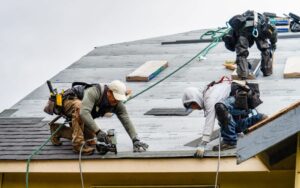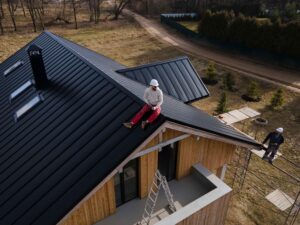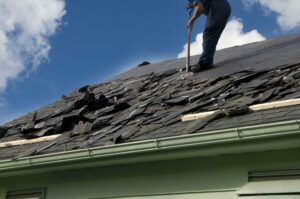When considering a new roof, the most significant expense often comes from the choice of materials and installation complexity. Premium options, like slate, can drive costs up considerably. But it’s not just about the materials; underlying issues with your roof structure can also inflate expenses. Understanding these factors is essential for making informed decisions about your roofing project. What other costs should you be aware of as you plan?
Factors That Influence the Cost of a New Roof
When considering a new roof, several key factors will greatly influence your overall costs. First, the choice of roofing material plays a critical role; asphalt shingles are affordable, while metal and slate offer durability but at a higher price. Next, assess any previous roof damage, as hidden leaks or structural issues may necessitate costly repairs. Labor complexity also affects installation costs; simpler roofs require less time and effort. Geographic location impacts labor pricing too, with urban areas often incurring higher expenses. Ultimately, seasonal demand can drive prices up during peak times. Each of these elements contributes to your total investment, making thorough evaluation essential for informed decision-making.
The Most Expensive Part of Roof Replacement
The choice of roofing material often represents the most significant expense in a roof replacement project. Asphalt shingles are the most common and affordable option, costing between $80 and $250 per 100 square feet. However, if you opt for metal roofing, expect to pay $100 to $800 per 100 square feet, but enjoy durability and energy efficiency for 40 to 70 years. Slate roofing, while offering unmatched longevity and aesthetic appeal, can cost between $600 and $1,600 per 100 square feet, requiring a robust structure and professional installation. Your choice impacts your budget, aesthetic preferences, and the roof’s lifespan, so carefully weigh the pros and cons of each material to make an informed decision.
Additional Costs That Can Add Up
Although choosing the right roofing material is essential, several additional costs can escalate your roof replacement budget considerably. Structural issues, such as damage to the roof deck, require significant repairs before installation, impacting overall expenses. Hidden leaks and water damage can further complicate the process, leading to unexpected costs if not detected early. Before committing to costly repairs or replacements, it’s essential to know how to visually inspect a roof to identify potential issues early. Weather-related damage may necessitate extra repairs, especially in areas prone to severe storms. Additionally, the complexity of installation, including the removal and disposal of old roofing materials, can increase labor costs. Special features like skylights, chimneys, or roof additions may also require meticulous attention, adding to the overall expense. Understanding these potential costs helps you prepare for an all-encompassing budget for your roof replacement.
Ways to Lower the Cost of Roof Replacement
To effectively lower the cost of roof replacement, start by carefully selecting your roofing material, as this decision plays a crucial role in your overall budget. Asphalt shingles are the most affordable option, offering decent durability and low maintenance costs. If you prioritize longevity and energy efficiency, consider metal roofing; although the initial investment is higher, the lifespan and savings on maintenance can offset this. Assess any pre-existing damage, as addressing structural issues early can prevent significant expenses later. Additionally, timing your installation during off-peak seasons can help reduce labor costs. Finally, guarantee quality workmanship; investing in skilled professionals can prevent future repairs and prolong your roof’s lifespan, ultimately saving you money in the long run.
Understanding the ROI of Expensive Roofing Parts
When considering a roof replacement, understanding the return on investment (ROI) for expensive roofing parts is vital. Higher upfront costs for materials like metal or slate can yield long-term benefits. For example, metal roofing, though initially pricier, offers durability and energy efficiency, potentially reducing maintenance and energy bills over its 40-70 year lifespan. Conversely, asphalt shingles are affordable but may require frequent repairs, impacting long-term ROI. Additionally, pre-existing damage and installation quality play significant roles; addressing structural issues guarantees a solid foundation for your new roof. Ultimately, investing in quality materials and craftsmanship can enhance your home’s value and longevity, making it a wise financial decision in the long run.
Frequently Asked Questions
How Do I Choose the Right Roofing Material?
To choose the right roofing material, consider your climate, budget, and desired aesthetics. Evaluate durability, maintenance requirements, and energy efficiency. Consulting with experienced contractors can provide valuable insights tailored to your specific needs and preferences.
What Is the Lifespan of Different Roofing Materials?
Different roofing materials have varying lifespans: asphalt shingles last 15-30 years, metal roofs can endure 40-70 years, while slate and tile may last over 100 years. Your choice impacts long-term durability and maintenance needs.
Can I Install a New Roof Over an Existing One?
Yes, you can install a new roof over an existing one, provided the structure supports it. However, verify local codes permit this method and evaluate existing conditions to avoid future complications. Always consult a professional.
How Do Weather Conditions Affect Roofing Costs?
Weather conditions greatly affect roofing costs; harsh climates can increase material prices and labor expenses. You’ll need to take into account potential delays and necessary adjustments to guarantee your roof withstands future weather challenges effectively.
What Permits Are Required for Roof Replacement?
Before starting roof replacement, you’ll need permits that vary by locality. Usually, you’ll require a building permit, and sometimes, a demolition permit. It’s crucial to check with your local authority to guarantee compliance.




